Medjugorje
“We bishops, after a three-year-long commission study accept Medjugorje as a holy place, as a shrine. This means that we have nothing against it if someone venerates the Mother of God in a manner also in agreement with the teaching and belief of the Church. Therefore, we are leaving that to further study. The Church does not hurry.”
His Eminence Cardinal Dr. Franjo KUHARIĆ, Archbishop of Zagreb
(Glas Koncila, August 15, 1993)
(See: Zadar' Declaration, Commentary of the Declaration,Congregatio pro doctrina fidei - Vatican ;
Ten years since the Zadar Declaration)
|
The Parish of Medjugorje
|
|
|
|
The parish of Medjugorje is situated in Herzegovina, 25 km southwest of Mostar. Medjugorje, (the name is of Slavic origin, and signifies a region between two mounts) with the villages of Bijakovići, Vionica, Miletina and Šurmanci, forms a Roman-Catholic parish where today (in 2005) about 5000 inhabitants live. The pastoral care of the parish is confided to the priests of the Herzegovinian Franciscan Province of the Assumption of Mary.
(See: Pastoral staff )
The whole region is inhabited by Croatians who received Christianity 13 centuries ago. In historical documents, the village was mentioned in 1599for the first time. The present parish was founded in 1892 and dedicated to St. James the Apostle, protector of pilgrims.
(See: A Short Historical Presentation)
|
|
Until June 24, 1981, Medjugorje lived like all other villages of this region: people worked on their land, planted tobacco and vineyards, produced wine and vegetables to acquire just enough for a modest life for their families. Because of social circumstances, many went out into the world: over the ocean and to Western European countries, as well as into towns in Bosnia-Herzegovina and Croatia.
(See: Regional References and the Population)
|
Our Lady's Apparitions
In 1981, when the apparitions started, the life of the parish changed: Our Lady chose for her witnesses and co-workers not only the six visionaries, but the entire parish and its pilgrims. This was expressly told in the following message: “I have chosen this parish in a special way and I wish to lead it.” (March 1st, 1984)
(See: OUR LADY'S MESSAGES)
On June 24th, 1981, at about 6 pm, six young people - Ivanka Ivanković, Mirjana Dragićević, Vicka Ivanković, Ivan Dragićević, Ivan Ivanković and Milka Pavlović, saw on the hill called Crnica, several hundred meters above the place called Podbrdo, a young woman with a child in her arms, who gave them a sign with her hand to come nearer. Surprised and scared, they did not approach her.
(See: Detailed Description of Our Lady, the Queen of Peace, as she appears in Medjugorje )
|
|
The next day, June 25th, 1981, at the same time, four of them: Ivanka Ivanković, Mirjana Dragićević, Vicka Ivanković and Ivan Dragićević, felt strongly drawn towards the place where they had seen the person the day before which, they had recognised as Our Lady. Marija avlović and Jakov Čolo joined them. The group of Medjugorje visionaries was formed. They prayed and spoke with Our Lady. This is why June 25th is celebrated as the Anniversary of the apparitions. According to the testimony of the visionaries, from that day onwards, they had daily apparitions, together or separately, wherever they were. Milka Pavlović and Ivan Ivanković never saw Our Lady again.
(See: Introduction to the messages; Our Lady's Apparitions Today)
The third day of the apparitions, June 26th, 1981, Our Lady gave the call to peace for the first time with the words: “Peace, peace, peace – and only peace! Peace must reign between God and man and between men!” Attracted by Our Lady’s apparitions and messages, people – first the parishioners and then from other villages and from all over the world – started to gather and pray.
|
|
The persecution of the visionaries, of their parents and relatives, of the parishioners and priests, and even of the pilgrims began immediately after the beginning of the apparitions. The visionaries were taken for police investigations and psychiatrical examinations, but it was always stated that they were healthy. The same conclusion brought about further examinations done in the following years.
(See: Scientific researches ; Apparitions, Visions, Revelations ; The Role of the Visionaries ; "Private" Revelation and Medjugorje )
|
|
Fr, Jozo Zovko, pastor of Medjugorje at that time, was arrested a month and a half after the first apparition. Although innocent, he was condemned by a communist court to three years and a half of prison.
|
|
Thanks to Our Lady’s apparitions, Medjugorje – a simple village parish – became a place of gathering for a multitude of pilgrims from the whole world (in the first 20 years, more then 20 million), and one of the biggest prayer centres in the world, comparable to Lourdes and Fatima. Innumerable witnesses say that, precisely in this place, they have found faith and peace.
(See: Anthropological, biblical, religious and spiritual dimensions of the pilgrimage ;
The Historical-Theological Context of the Medjugorje Apparitions; Statistics)
According to the unanimous witness of the visionaries, Our Lady gives them messages to be transmitted to the parish and to the world. They mainly address PEACE, FAITH, CONVERSION, PRAYER AND FASTING. The parishioners and the pilgrims have to become witnesses of Our Lady’s apparitions and messages first, and then, together with the visionaries, join her in the realisation of the plan of the conversion of the world and its reconciliation with God.
|
|
At the end of 1982, Our Lady addressed herself through inner locutions (locutio cordis) to two ten years old girls, Jelena and Marijana Vasilj. Through their prayer group, she gave - from 1983 to 1987 - counsel to the prayer movement that was created from the very beginning of the apparitions.
Our Lady's messages given in Medjugorje constitute a specific school of peace, of prayer and of love.
(See: The Spiritual Movement of the Queen of Peace ; Prayer Groups in the Marian Prayer Movement; Medjugorje and the New Evangelisation)
|
St. James’ Parish Church
The construction of the old parish church was completed in 1897, soon after the creation of the parish (1892). It was a spacious and beautiful construction for its time. Built on unstable ground, it soon started to develop fissures. Immediately after the end of the First World War, the parishioners began to think about building a new church. Construction lasted from 1934 until January 19, 1969, when it was consecrated.
(See: Virtual walk)
|
|
St James Church is today the focus and the centre of both sacramental and prayer life, not only for the parishioners, but also for pilgrims.
(See: International meetings; Weekly programme; Annual programme)
|
|
A fenced-in park situated within the traffic circle at the east side of the Shrine reminds us of the place where the old parish church once stood.
|
THE EXTERIOR ALTAR
Because of new needs, which surfaced with the coming of numerous pilgrims, the church and its surroundings have been rearranged ever since 1981.
(See: Virtual walk)
|
|
The exterior altar built in 1989, and the surrounding prayer area (with about 5000 seats), are a place of gathering in the summer time and for big feasts, when numerous thousands of pilgrims gather in Medjugorje.
(See: Guidelines and Information for Pilgrims )
|
Apparition Hill
The place of the first apparitions of Our Lady, several hundreds meters above the Bijakovići hamlet called Podbrdo, is today called Apparition Hill.
(See: Virtual walk)
|
|
A steep path leads from the houses to the very place of the apparitions, along which – in 1989 – bronze reliefs were placed representing the joyful and the sorrowful mysteries of the Rosary (the work of Prof. Carmelo Puzzolo).
|
|
On the way towards the place of the apparitions, a large wooden cross was erected, signalling the place where – through Marija Pavlović, on the third day of the apparitions – Our Lady gave the call to peace for the first time.
|
|
At the very place of the apparitions, in honour of the 20th anniversary of the apparitions, a statue of the Queen of Peace was placed, sculpted according to the model of the statue, which you can find in front of the parish church (the work of Dino Felici).
|
|
For the pilgrims, an encounter with Apparition Hill is encounter with Our Lady through personal prayer and prayer of the rosary.
|
|
In June 2002, bronze reliefs representing the glorious mysteries of the Rosary (the work of Prof. Carmelo Puzzolo) were placed on the path descending towards the Blue Cross.
|
|
At the foot of Apparition Hill is the Blue Cross, placed there in 1985. At this place, Ivan the visionary’s prayer group gathers regularly, ever since July 4th, 1982.
|
Cross Mountain (KRIŽEVAC)
Cross Mountain is a mount above Medjugorje (520 m) where on March 15, 1934, the parishioners constructed a concrete cross 8.56 m high, built in remembrance of the 1900 years since the death of Jesus. On the cross is written: “To Jesus Christ, Redeemer of the human race, as a sign of their faith, love and hope, in remembrance of the 1900 years since the death of Jesus”.
(See: Virtual walk)
|
|
Relics received from Rome for the occasion are embedded in the cross bar itself.
|
|
Since then, the custom was established of celebrating Holy Mass at the foot of the cross in commemoration of the Exaltation of the Holy Cross, on the 1st Sunday after the Feast of the Nativity of the Blessed Virgin Mary.
|
|
According to the visionaries, in the message of August 30, 1984, Our Lady said: “The cross was also in God's plan when you built it.”
|
|
With Our Lady’s apparitions, the faithful started to pray the Way of the Cross on Cross Mountain. In the beginning, the stations were marked with simple wooden crosses, and in 1988, bronze reliefs (the work of Carmelo Puzzolo) were placed there. On each one of them, with the exception of the Garden of Gethsemane, Our Lady is situated.
|
|
For the pilgrims, Cross Mountain is a call to meet Jesus in His Passion and to discover His love.
|
|
On the first death anniversary of Fr. Slavko Barbarić (November 24, 2001), on the place where he gave his soul into the hands of the Lord, a memorial was erected: Fr. Slavko’s relief in bronze encrusted in stone. Between two stations of the cross, it will remain as a sign and a memorial of a man who said what he thought and who did what he said, following the Gospel and the messages of the Mother of the Word Incarnate, the Queen of Peace.
|
Prayer Area Around the Parish Church
Adoration Chapel
The Adoration Chapel was built in 1991, to offer a place for silent adoration of Jesus in the Most Blessed Sacrament of the Altar to the pilgrims. Due to the lack of prayer space at the Shrine, Holy Masses in different languages are celebrated there during the morning, but it is open for personal prayer during the afternoon.
In the year 2000, reliefs of five priests, natives of the parish, martyrs for the faith, killed by the communists at the very end of the World War II, were placed in the adoration chapel.
|
Statue OF the Queen of Peace
The marble statue of the Queen of Peace, which became a symbol of the Shrine (the work of Dino Felici from Italy) was put up in 1987 at the square in front of the church.
|
Confessionals
Thanks to Our Lady’s apparitions, Medjugorje became a place of reconciliation, which is especially experienced in the sacrament of Holy Confession. Twenty-five confessionals, built in 1990 and restored in 2001, can be found near the church; it is there that the faithful have daily occasion to experience God’s forgiveness.
(See: Virtual walk)
|
Statue of St. LEOPOLD BOGDAN MANDIĆ
The bronze statue of St. Leopold Bogdan Mandić (the work of Carmelo Puzzolo from Italy), patron saint of confessors, canonised on October 16, 1983, was put up in 1998 in the proximity of the exterior confessionals.
|
Prayer Area Around the Wooden Cross
At the northwest of the church, an area for silent prayer was arranged around a wooden cross. This is the place where pilgrims can light their votive candles.
(See: Virtual walk)
|
Outside Area for Meetings and Leisure for pilgrims
A covered area for meetings and leisure for pilgrims was constructed in 2000. Behind it, you can find the toilet facilities.
|
Prayer Area Around the Statue of the Risen Saviour
At southwest of the church, on the way towards the cemetery, a bronze statue of the Risen Saviour (the work of Slovenian sculptor Andrej Ajdič) was put up for Easter 1998. For Easter 2002, a space was arranged around the statue for personal and group prayer of the Stations of the Cross for those who cannot climb Cross Mountain.
|
Hall for Group Meetings and the PAINTING of the Queen of Peace
Prayer gatherings of pilgrims in the parish demanded the construction of a space for conferences, prayer meetings and international seminars. The Hall, which seats 800, was built in 1998.
|
|
There, you can also find a painting of the Queen of Peace (oil on tissue, work of Prof. Carmelo Puzzolo).
|
CEMETERY “KOVAČICA”
The local cemetery “Kovačica” is where Fr. Slavko Barbarić is buried, as well as Fr. Križan Galić, who was killed by the partisans in the presbytery while he was Pastor in Medjugorje.
|
Different services
PRESBYTERY
The presbytery, built in 1892, immediately after the creation of the parish, was restored in 1990. At the time when the old parish church was still under construction, when it was unsuitable for use, as well as during the war in 1992, Holy Mass was celebrated in its cellar.
The door of the presbytery is always open not only for the parishioners, but also for the pilgrims of the whole world.
In the presbytery, in the room where he was killed by the communists, you can find the relief of Fr. Križan Galić.
|
Information Booth
The Information Booth was created in 1991 and was re-established after the war in 1995. It serves the organisation of the pilgrim’s programme at the Shrine: it centralises the registration of pilgrimages, establishes contact with guides and organises meetings with Medjugorje Franciscans and visionaries. The Association of Guides, established for the bettering service to pilgrims, is tightly linked to the Information Booth.
(See: INFORMATION CENTRE “MIR” MEDJUGORJE )
|
Souvenir Shop
In Medjugorje, as in other places of pilgrimages, pilgrims have the desire and the need to take home a souvenir of the experience they have made. Near the Presbytery is situated a Souvenir Shop, where pilgrims can find rosaries, crosses, medals, holy pictures, books, music, video/audio tapes, and other religious objects.
|
First Aid Station
The First Aid Station, opened in spring 2003, is on the west side of the Shrine, near the parking. Medical Service of the Maltese Order helps pilgrims and parishioners daily from 9 am to 9 pm, from May 1st to November 1st.
(See: Contacts)
|
Parking
The parking lot, where pilgrims can leave their personal vehicles and busses, is on the west side of the Shrine.
|
Institutions linked to THE shrine
Domus Pacis (House of Peace)
“Domus Pacis” is a house of prayer, bought in 1990, where prayer seminars (especially “Prayer and Fasting Seminars”), retreats and recollection days for local and foreign pilgrims take place.
|
Mother’s Village
Mother’s Village is an establishment for the education and care of abandoned and neglected children. It has existed since 1993. It emerged from the desire of its founder, Fr. Slavko Barbarić, to offer children and youth a planned, organised education, as well as care, so that they can develop physically, intellectually, morally, spiritually and culturally. Through Catholic contents and ideas, the collaborators offer them a condition of freedom, dignity, acceptance, and above all, love and understanding.
The care of children was entrusted to the Franciscan School Sisters from Herzegovina, and to lay staff members. The establishment started its work officially on September 8, 1996.
A Kindergarten, a Dentist’s Lab and a Physical Therapy Station are also on the Mother’s Village Campus.
(See: Mother's Village)
|
St. Francis’ Garden
St. Francis’ Garden, a forest in the northwest part of Mother’s Village, was the last project of the late Fr. Slavko Barbarić, inspired by Our Lady’s message, where she tells us: “Go into nature and look how nature is awakening and it will be a help to you to open your hearts to the love of God, the Creator.” (April 25, 1993)
Through patient work and care, a neglected pine forest grown on rocky ground became a beautiful natural place for recollection and recreation, prayer and education. There are also two little artificial lakes, didactical material for work with children, several domestic and wild animals and birds, as well as three ponies, which serve for hypotherapy (therapeutical riding adapted for handicapped children).
(See: St. Francis' Garden)
|
The Cenacolo Community
The “Cenacolo” Community was founded in Saluzzo (Italy) by Sr. Elvira Petrozzi in 1983, in order to help drug addicts. The main goal of the community is to discover and to live true values of Christian life. According to their words, their therapy is Jesus Christ, and the way of healing is prayer, work and friendship.
Because of special graces, which young people in search of truth receive in Medjugorje, Sr. Elvira opened two houses here: a house for boys called “Field of Life”, in 1991, and a house for girls called “Field of Joy” in 2000.
The boys of the “Cenacolo” community gladly receive pilgrims and give witness of their conversion and liberation from drug addiction.
(See: www.campo-della-vita.org )
|
|
In conformity to Pope Urban VIII’ Decree and the directives of the Council Vatican II, the author declares not to have the intention to precede the judgment of the Church, to whom he submits himself fully. Words like “apparitions, messages” and similar have here the value of human witness.
Prepared in June 2002
(See: Contacts)
|

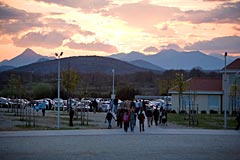






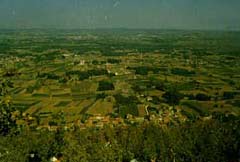 Until June 24, 1981, Medjugorje lived like all other villages of this region: people worked on their land, planted tobacco and vineyards, produced wine and vegetables to acquire just enough for a modest life for their families. Because of social circumstances, many went out into the world: over the ocean and to Western European countries, as well as into towns in Bosnia-Herzegovina and Croatia.
Until June 24, 1981, Medjugorje lived like all other villages of this region: people worked on their land, planted tobacco and vineyards, produced wine and vegetables to acquire just enough for a modest life for their families. Because of social circumstances, many went out into the world: over the ocean and to Western European countries, as well as into towns in Bosnia-Herzegovina and Croatia. 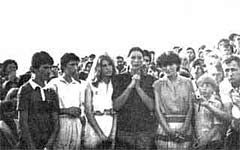 In 1981, when the apparitions started, the life of the parish changed: Our Lady chose for her witnesses and co-workers not only the six visionaries, but the entire parish and its pilgrims. This was expressly told in the following message: “I have chosen this parish in a special way and I wish to lead it.” (March 1st, 1984)
In 1981, when the apparitions started, the life of the parish changed: Our Lady chose for her witnesses and co-workers not only the six visionaries, but the entire parish and its pilgrims. This was expressly told in the following message: “I have chosen this parish in a special way and I wish to lead it.” (March 1st, 1984) 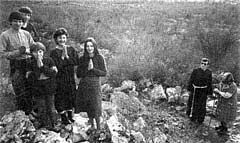 The next day, June 25th, 1981, at the same time, four of them: Ivanka Ivanković, Mirjana Dragićević, Vicka Ivanković and Ivan Dragićević, felt strongly drawn towards the place where they had seen the person the day before which, they had recognised as Our Lady. Marija avlović and Jakov Čolo joined them. The group of Medjugorje visionaries was formed. They prayed and spoke with Our Lady. This is why June 25th is celebrated as the Anniversary of the apparitions. According to the testimony of the visionaries, from that day onwards, they had daily apparitions, together or separately, wherever they were. Milka Pavlović and Ivan Ivanković never saw Our Lady again.
The next day, June 25th, 1981, at the same time, four of them: Ivanka Ivanković, Mirjana Dragićević, Vicka Ivanković and Ivan Dragićević, felt strongly drawn towards the place where they had seen the person the day before which, they had recognised as Our Lady. Marija avlović and Jakov Čolo joined them. The group of Medjugorje visionaries was formed. They prayed and spoke with Our Lady. This is why June 25th is celebrated as the Anniversary of the apparitions. According to the testimony of the visionaries, from that day onwards, they had daily apparitions, together or separately, wherever they were. Milka Pavlović and Ivan Ivanković never saw Our Lady again. 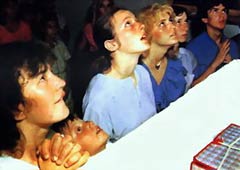 The persecution of the visionaries, of their parents and relatives, of the parishioners and priests, and even of the pilgrims began immediately after the beginning of the apparitions. The visionaries were taken for police investigations and psychiatrical examinations, but it was always stated that they were healthy. The same conclusion brought about further examinations done in the following years.
The persecution of the visionaries, of their parents and relatives, of the parishioners and priests, and even of the pilgrims began immediately after the beginning of the apparitions. The visionaries were taken for police investigations and psychiatrical examinations, but it was always stated that they were healthy. The same conclusion brought about further examinations done in the following years.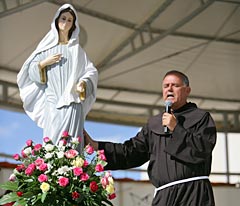 Fr, Jozo Zovko, pastor of Medjugorje at that time, was arrested a month and a half after the first apparition. Although innocent, he was condemned by a communist court to three years and a half of prison.
Fr, Jozo Zovko, pastor of Medjugorje at that time, was arrested a month and a half after the first apparition. Although innocent, he was condemned by a communist court to three years and a half of prison.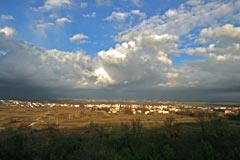 Thanks to Our Lady’s apparitions, Medjugorje – a simple village parish – became a place of gathering for a multitude of pilgrims from the whole world (in the first 20 years, more then 20 million), and one of the biggest prayer centres in the world, comparable to Lourdes and Fatima. Innumerable witnesses say that, precisely in this place, they have found faith and peace.
Thanks to Our Lady’s apparitions, Medjugorje – a simple village parish – became a place of gathering for a multitude of pilgrims from the whole world (in the first 20 years, more then 20 million), and one of the biggest prayer centres in the world, comparable to Lourdes and Fatima. Innumerable witnesses say that, precisely in this place, they have found faith and peace. 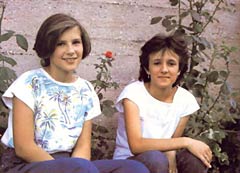 At the end of 1982, Our Lady addressed herself through inner locutions (locutio cordis) to two ten years old girls, Jelena and Marijana Vasilj. Through their prayer group, she gave - from 1983 to 1987 - counsel to the prayer movement that was created from the very beginning of the apparitions.
At the end of 1982, Our Lady addressed herself through inner locutions (locutio cordis) to two ten years old girls, Jelena and Marijana Vasilj. Through their prayer group, she gave - from 1983 to 1987 - counsel to the prayer movement that was created from the very beginning of the apparitions.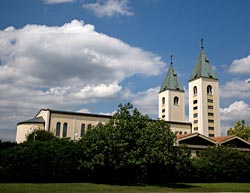 The construction of the old parish church was completed in 1897, soon after the creation of the parish (1892). It was a spacious and beautiful construction for its time. Built on unstable ground, it soon started to develop fissures. Immediately after the end of the First World War, the parishioners began to think about building a new church. Construction lasted from 1934 until January 19, 1969, when it was consecrated.
The construction of the old parish church was completed in 1897, soon after the creation of the parish (1892). It was a spacious and beautiful construction for its time. Built on unstable ground, it soon started to develop fissures. Immediately after the end of the First World War, the parishioners began to think about building a new church. Construction lasted from 1934 until January 19, 1969, when it was consecrated.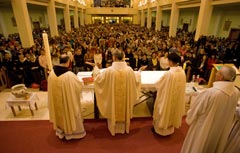 St James Church is today the focus and the centre of both sacramental and prayer life, not only for the parishioners, but also for pilgrims.
St James Church is today the focus and the centre of both sacramental and prayer life, not only for the parishioners, but also for pilgrims. 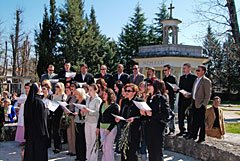 A fenced-in park situated within the traffic circle at the east side of the Shrine reminds us of the place where the old parish church once stood.
A fenced-in park situated within the traffic circle at the east side of the Shrine reminds us of the place where the old parish church once stood.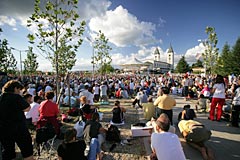 Because of new needs, which surfaced with the coming of numerous pilgrims, the church and its surroundings have been rearranged ever since 1981.
Because of new needs, which surfaced with the coming of numerous pilgrims, the church and its surroundings have been rearranged ever since 1981.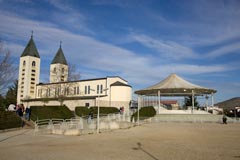 The exterior altar built in 1989, and the surrounding prayer area (with about 5000 seats), are a place of gathering in the summer time and for big feasts, when numerous thousands of pilgrims gather in Medjugorje.
The exterior altar built in 1989, and the surrounding prayer area (with about 5000 seats), are a place of gathering in the summer time and for big feasts, when numerous thousands of pilgrims gather in Medjugorje. 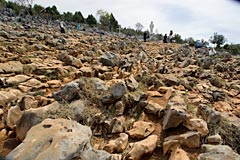 The place of the first apparitions of Our Lady, several hundreds meters above the Bijakovići hamlet called Podbrdo, is today called Apparition Hill.
The place of the first apparitions of Our Lady, several hundreds meters above the Bijakovići hamlet called Podbrdo, is today called Apparition Hill.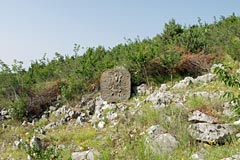 A steep path leads from the houses to the very place of the apparitions, along which – in 1989 – bronze reliefs were placed representing the joyful and the sorrowful mysteries of the Rosary (the work of Prof. Carmelo Puzzolo).
A steep path leads from the houses to the very place of the apparitions, along which – in 1989 – bronze reliefs were placed representing the joyful and the sorrowful mysteries of the Rosary (the work of Prof. Carmelo Puzzolo). On the way towards the place of the apparitions, a large wooden cross was erected, signalling the place where – through Marija Pavlović, on the third day of the apparitions – Our Lady gave the call to peace for the first time.
On the way towards the place of the apparitions, a large wooden cross was erected, signalling the place where – through Marija Pavlović, on the third day of the apparitions – Our Lady gave the call to peace for the first time.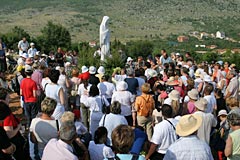 At the very place of the apparitions, in honour of the 20th anniversary of the apparitions, a statue of the Queen of Peace was placed, sculpted according to the model of the statue, which you can find in front of the parish church (the work of Dino Felici).
At the very place of the apparitions, in honour of the 20th anniversary of the apparitions, a statue of the Queen of Peace was placed, sculpted according to the model of the statue, which you can find in front of the parish church (the work of Dino Felici).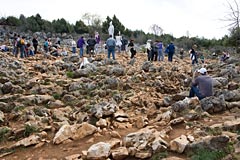 For the pilgrims, an encounter with Apparition Hill is encounter with Our Lady through personal prayer and prayer of the rosary.
For the pilgrims, an encounter with Apparition Hill is encounter with Our Lady through personal prayer and prayer of the rosary.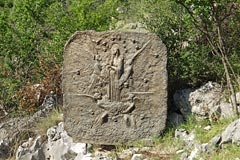 In June 2002, bronze reliefs representing the glorious mysteries of the Rosary (the work of Prof. Carmelo Puzzolo) were placed on the path descending towards the Blue Cross.
In June 2002, bronze reliefs representing the glorious mysteries of the Rosary (the work of Prof. Carmelo Puzzolo) were placed on the path descending towards the Blue Cross.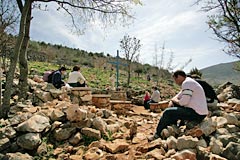 At the foot of Apparition Hill is the Blue Cross, placed there in 1985. At this place, Ivan the visionary’s prayer group gathers regularly, ever since July 4th, 1982.
At the foot of Apparition Hill is the Blue Cross, placed there in 1985. At this place, Ivan the visionary’s prayer group gathers regularly, ever since July 4th, 1982.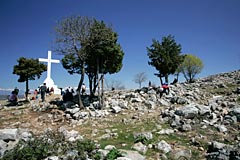 Cross Mountain is a mount above Medjugorje (520 m) where on March 15, 1934, the parishioners constructed a concrete cross 8.56 m high, built in remembrance of the 1900 years since the death of Jesus. On the cross is written: “To Jesus Christ, Redeemer of the human race, as a sign of their faith, love and hope, in remembrance of the 1900 years since the death of Jesus”.
Cross Mountain is a mount above Medjugorje (520 m) where on March 15, 1934, the parishioners constructed a concrete cross 8.56 m high, built in remembrance of the 1900 years since the death of Jesus. On the cross is written: “To Jesus Christ, Redeemer of the human race, as a sign of their faith, love and hope, in remembrance of the 1900 years since the death of Jesus”.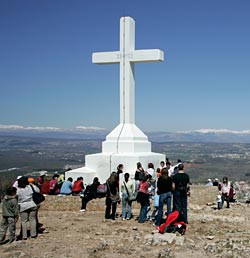 Relics received from Rome for the occasion are embedded in the cross bar itself.
Relics received from Rome for the occasion are embedded in the cross bar itself.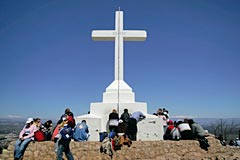 Since then, the custom was established of celebrating Holy Mass at the foot of the cross in commemoration of the Exaltation of the Holy Cross, on the 1st Sunday after the Feast of the Nativity of the Blessed Virgin Mary.
Since then, the custom was established of celebrating Holy Mass at the foot of the cross in commemoration of the Exaltation of the Holy Cross, on the 1st Sunday after the Feast of the Nativity of the Blessed Virgin Mary.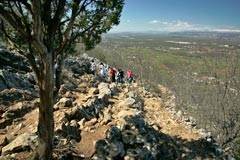 According to the visionaries, in the message of August 30, 1984, Our Lady said: “The cross was also in God's plan when you built it.”
According to the visionaries, in the message of August 30, 1984, Our Lady said: “The cross was also in God's plan when you built it.”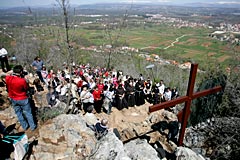 With Our Lady’s apparitions, the faithful started to pray the Way of the Cross on Cross Mountain. In the beginning, the stations were marked with simple wooden crosses, and in 1988, bronze reliefs (the work of Carmelo Puzzolo) were placed there. On each one of them, with the exception of the Garden of Gethsemane, Our Lady is situated.
With Our Lady’s apparitions, the faithful started to pray the Way of the Cross on Cross Mountain. In the beginning, the stations were marked with simple wooden crosses, and in 1988, bronze reliefs (the work of Carmelo Puzzolo) were placed there. On each one of them, with the exception of the Garden of Gethsemane, Our Lady is situated.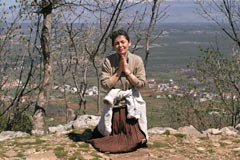 For the pilgrims, Cross Mountain is a call to meet Jesus in His Passion and to discover His love.
For the pilgrims, Cross Mountain is a call to meet Jesus in His Passion and to discover His love.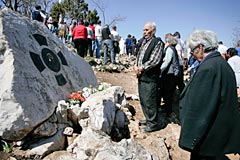 On the first death anniversary of Fr. Slavko Barbarić (November 24, 2001), on the place where he gave his soul into the hands of the Lord, a memorial was erected: Fr. Slavko’s relief in bronze encrusted in stone. Between two stations of the cross, it will remain as a sign and a memorial of a man who said what he thought and who did what he said, following the Gospel and the messages of the Mother of the Word Incarnate, the Queen of Peace.
On the first death anniversary of Fr. Slavko Barbarić (November 24, 2001), on the place where he gave his soul into the hands of the Lord, a memorial was erected: Fr. Slavko’s relief in bronze encrusted in stone. Between two stations of the cross, it will remain as a sign and a memorial of a man who said what he thought and who did what he said, following the Gospel and the messages of the Mother of the Word Incarnate, the Queen of Peace.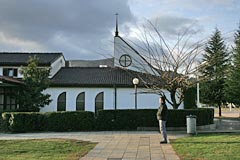 The Adoration Chapel was built in 1991, to offer a place for silent adoration of Jesus in the Most Blessed Sacrament of the Altar to the pilgrims. Due to the lack of prayer space at the Shrine, Holy Masses in different languages are celebrated there during the morning, but it is open for personal prayer during the afternoon.
The Adoration Chapel was built in 1991, to offer a place for silent adoration of Jesus in the Most Blessed Sacrament of the Altar to the pilgrims. Due to the lack of prayer space at the Shrine, Holy Masses in different languages are celebrated there during the morning, but it is open for personal prayer during the afternoon.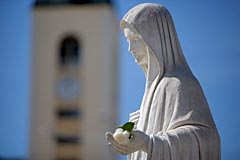 The marble statue of the Queen of Peace, which became a symbol of the Shrine (the work of Dino Felici from Italy) was put up in 1987 at the square in front of the church.
The marble statue of the Queen of Peace, which became a symbol of the Shrine (the work of Dino Felici from Italy) was put up in 1987 at the square in front of the church.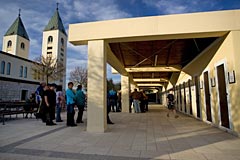 Thanks to Our Lady’s apparitions, Medjugorje became a place of reconciliation, which is especially experienced in the sacrament of Holy Confession. Twenty-five confessionals, built in 1990 and restored in 2001, can be found near the church; it is there that the faithful have daily occasion to experience God’s forgiveness.
Thanks to Our Lady’s apparitions, Medjugorje became a place of reconciliation, which is especially experienced in the sacrament of Holy Confession. Twenty-five confessionals, built in 1990 and restored in 2001, can be found near the church; it is there that the faithful have daily occasion to experience God’s forgiveness.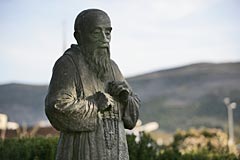 The bronze statue of St. Leopold Bogdan Mandić (the work of Carmelo Puzzolo from Italy), patron saint of confessors, canonised on October 16, 1983, was put up in 1998 in the proximity of the exterior confessionals.
The bronze statue of St. Leopold Bogdan Mandić (the work of Carmelo Puzzolo from Italy), patron saint of confessors, canonised on October 16, 1983, was put up in 1998 in the proximity of the exterior confessionals.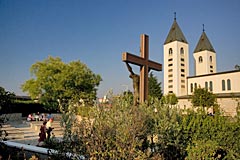
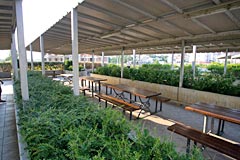 A covered area for meetings and leisure for pilgrims was constructed in 2000. Behind it, you can find the toilet facilities.
A covered area for meetings and leisure for pilgrims was constructed in 2000. Behind it, you can find the toilet facilities.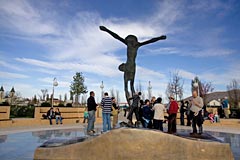 At southwest of the church, on the way towards the cemetery, a bronze statue of the Risen Saviour (the work of Slovenian sculptor Andrej Ajdič) was put up for Easter 1998. For Easter 2002, a space was arranged around the statue for personal and group prayer of the Stations of the Cross for those who cannot climb Cross Mountain.
At southwest of the church, on the way towards the cemetery, a bronze statue of the Risen Saviour (the work of Slovenian sculptor Andrej Ajdič) was put up for Easter 1998. For Easter 2002, a space was arranged around the statue for personal and group prayer of the Stations of the Cross for those who cannot climb Cross Mountain.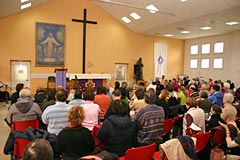 Prayer gatherings of pilgrims in the parish demanded the construction of a space for conferences, prayer meetings and international seminars. The Hall, which seats 800, was built in 1998.
Prayer gatherings of pilgrims in the parish demanded the construction of a space for conferences, prayer meetings and international seminars. The Hall, which seats 800, was built in 1998.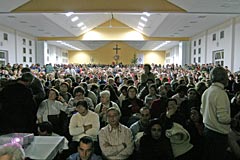 There, you can also find a painting of the Queen of Peace (oil on tissue, work of Prof. Carmelo Puzzolo).
There, you can also find a painting of the Queen of Peace (oil on tissue, work of Prof. Carmelo Puzzolo).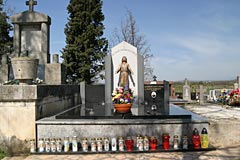 The local cemetery “Kovačica” is where Fr. Slavko Barbarić is buried, as well as Fr. Križan Galić, who was killed by the partisans in the presbytery while he was Pastor in Medjugorje.
The local cemetery “Kovačica” is where Fr. Slavko Barbarić is buried, as well as Fr. Križan Galić, who was killed by the partisans in the presbytery while he was Pastor in Medjugorje.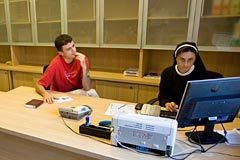 mediately after the creation of the parish, was restored in 1990. At the time when the old parish church was still under construction, when it was unsuitable for use, as well as during the war in 1992, Holy Mass was celebrated in its cellar.
mediately after the creation of the parish, was restored in 1990. At the time when the old parish church was still under construction, when it was unsuitable for use, as well as during the war in 1992, Holy Mass was celebrated in its cellar.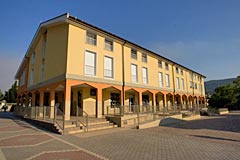 ated in 1991 and was re-established after the war in 1995. It serves the organisation of the pilgrim’s programme at the Shrine: it centralises the registration of pilgrimages, establishes contact with guides and organises meetings with Medjugorje Franciscans and visionaries. The Association of Guides, established for the bettering service to pilgrims, is tightly linked to the Information Booth.
ated in 1991 and was re-established after the war in 1995. It serves the organisation of the pilgrim’s programme at the Shrine: it centralises the registration of pilgrimages, establishes contact with guides and organises meetings with Medjugorje Franciscans and visionaries. The Association of Guides, established for the bettering service to pilgrims, is tightly linked to the Information Booth. 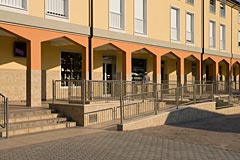 In Medjugorje, as in other places of pilgrimages, pilgrims have the desire and the need to take home a souvenir of the experience they have made. Near the Presbytery is situated a Souvenir Shop, where pilgrims can find rosaries, crosses, medals, holy pictures, books, music, video/audio tapes, and other religious objects.
In Medjugorje, as in other places of pilgrimages, pilgrims have the desire and the need to take home a souvenir of the experience they have made. Near the Presbytery is situated a Souvenir Shop, where pilgrims can find rosaries, crosses, medals, holy pictures, books, music, video/audio tapes, and other religious objects.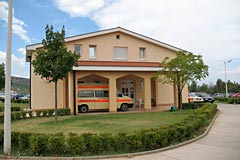 The First Aid Station, opened in spring 2003, is on the west side of the Shrine, near the parking. Medical Service of the Maltese Order helps pilgrims and parishioners daily from 9 am to 9 pm, from May 1st to November 1st.
The First Aid Station, opened in spring 2003, is on the west side of the Shrine, near the parking. Medical Service of the Maltese Order helps pilgrims and parishioners daily from 9 am to 9 pm, from May 1st to November 1st. “Domus Pacis” is a house of prayer, bought in 1990, where prayer seminars (especially “Prayer and Fasting Seminars”), retreats and recollection days for local and foreign pilgrims take place.
“Domus Pacis” is a house of prayer, bought in 1990, where prayer seminars (especially “Prayer and Fasting Seminars”), retreats and recollection days for local and foreign pilgrims take place.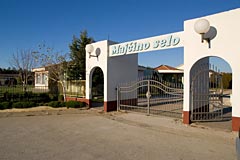 Mother’s Village is an establishment for the education and care of abandoned and neglected children. It has existed since 1993. It emerged from the desire of its founder, Fr. Slavko Barbarić, to offer children and youth a planned, organised education, as well as care, so that they can develop physically, intellectually, morally, spiritually and culturally. Through Catholic contents and ideas, the collaborators offer them a condition of freedom, dignity, acceptance, and above all, love and understanding.
Mother’s Village is an establishment for the education and care of abandoned and neglected children. It has existed since 1993. It emerged from the desire of its founder, Fr. Slavko Barbarić, to offer children and youth a planned, organised education, as well as care, so that they can develop physically, intellectually, morally, spiritually and culturally. Through Catholic contents and ideas, the collaborators offer them a condition of freedom, dignity, acceptance, and above all, love and understanding.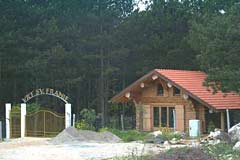 St. Francis’ Garden, a forest in the northwest part of Mother’s Village, was the last project of the late Fr. Slavko Barbarić, inspired by Our Lady’s message, where she tells us: “Go into nature and look how nature is awakening and it will be a help to you to open your hearts to the love of God, the Creator.” (April 25, 1993)
St. Francis’ Garden, a forest in the northwest part of Mother’s Village, was the last project of the late Fr. Slavko Barbarić, inspired by Our Lady’s message, where she tells us: “Go into nature and look how nature is awakening and it will be a help to you to open your hearts to the love of God, the Creator.” (April 25, 1993)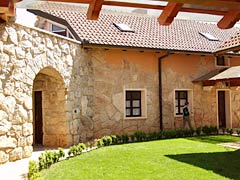 The “Cenacolo” Community was founded in Saluzzo (Italy) by Sr. Elvira Petrozzi in 1983, in order to help drug addicts. The main goal of the community is to discover and to live true values of Christian life. According to their words, their therapy is Jesus Christ, and the way of healing is prayer, work and friendship.
The “Cenacolo” Community was founded in Saluzzo (Italy) by Sr. Elvira Petrozzi in 1983, in order to help drug addicts. The main goal of the community is to discover and to live true values of Christian life. According to their words, their therapy is Jesus Christ, and the way of healing is prayer, work and friendship.